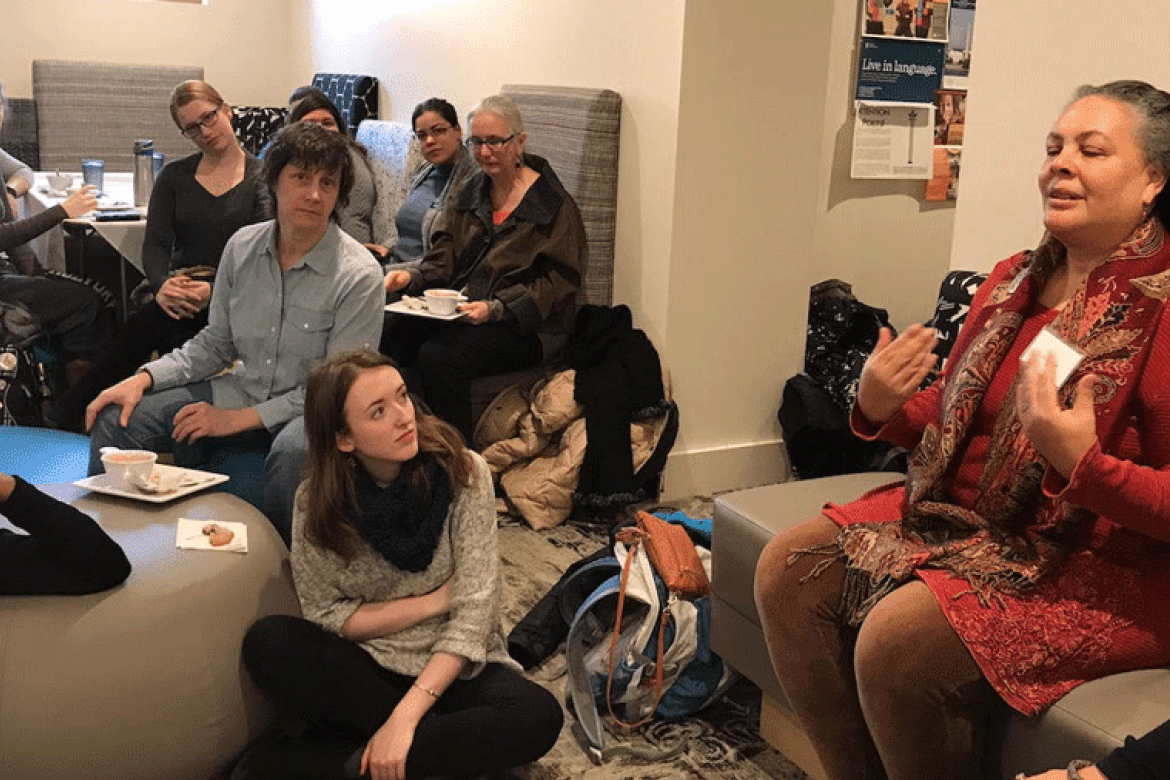Food, faith, fellowship

Mount Holyoke’s Interfaith Lunch serves up conversation — with sides of soup, cookies and laughter — every Wednesday in the new Unity Space.
“I have lots of friends who are Jewish or Muslim, but I don’t want to put them on the spot by asking them about their religions,” said Elise Newcomer ’18, a self-described Christian who double majors in French and history. “The lunches are a great way to learn about other religions.”
Newcomer is talking about the Interfaith Lunch at Mount Holyoke College, held first in Eliot House and now in the cozy new Unity Center in Blanchard Hall, part of the College’s new Community Center. In a warm, welcoming atmosphere, members of the College community come together weekly over food to find fellowship and to learn more about other faiths and spiritual practices.
Interfaith life and practice is an integral part of a liberal arts education and a central focus of Mount Holyoke’s Office of Religious and Spiritual Life. The scope and depth of the office’s activities reflect the diversity of the student body, including 27 percent who are from countries around the world, the majority from China and Pakistan.
“Whether our students are from Shanghai or a Boston suburb, we offer them ways to stay connected to their religion or spiritual path and to broaden their understanding of other faiths,” said the office’s dean, Annette McDermott. The office includes seven staff spiritual leaders and supports nine faith groups on campus: Bahá'í, Buddhist, Catholic, Earth-based spirituality/Pagan/Wiccan, Hindu, Jewish, Muslim, Protestant and Unitarian Universalist.
The office maintains a full calendar of workshops, meals, feasts and festivals. In just one typical week in February, for example, students could attend Ash Wednesday observances, a black history–themed community shabbat, a chai fundraiser organized by the Muslim Students Association and a yoga nidra (guided relaxation) session.
And that’s not even the annual Interfaith Awareness Week, which begins this year on the evening of Feb. 27 with the popular Latke-Hamantaschen Debate, sponsored by the Jewish Student Union.
Next fall, a group of students will move into the College’s first interfaith Living-Learning Community, which will be a place where students of faith and non-faith are invited to explore and celebrate the diversity of religious, spiritual and socially just practices.
“When a survey went out to everyone on the Eliot House email list, an overwhelming number of people responded,” Emily Carle ’21, told the Mount Holyoke News in an article about the new communities.
But back to lunch: On any given Wednesday at noon during the semester, 30 or more people, mostly students but also faculty, staff and alumnae, can be found in the Unity Center. Many are regulars but newcomers are always welcome. They greet one another, chat animatedly and line up for a delicious, discreetly vegan lunch of soup, bread, fresh greens and an array of Chef Jeff cookies. Eventually, everyone slides onto banquettes upholstered in patterned prints of black, white and gray, or perches on ottomans and stools in Easter-egg shades of pink, lime and lemon yellow.
The lunches, which have been held for two decades, are themed and frequently feature special guests. Ami Campbell ’92 recently spoke about generosity, the topic of her book “Love Let Go: Radical Generosity for the Real World.” At another lunch, two quilters from the Boston-area organization Sisters In Stitches Joined By The Cloth launched a project to produce colorful wall hangings for the Unity Center. Students often give presentations about their experiences with faith.
At all times, the lunches give students the chance to share what’s going on in their lives and hearts. At the start of the spring semester, for instance, Leslie Fraser, the multifaith chaplin, invited the gathering to talk about winter break. Without skipping a beat, people spoke up, describing uplifting or awkward experiences in which religion played a part. Feeling judged for not being “the right kind of Christian” by hometown friends. Attending Catholic mass with Dad and coming away feeling newly reconnected to faith, to family.
“I’ve been dying to share!” said Aicha Belabbes ’19. An English major, she’d studied abroad in Belfast, Northern Ireland, last fall “to explore the form that bridges and connections take in a post-conflict society.”
To her chagrin, “When it came to interfaith, I saw none,” Belabbes said. “What I saw overwhelmingly was fear. In pubs, which are the center of social life in Belfast, people seemed to ‘up-play’ versus downplay conflict. I thought not being a Catholic or Protestant, I’d have a free pass, but people tried to put me on a side.”
There’s no need to choose sides at the Interfaith Lunch. “We want these lunches to be a model for conversation, for discourse, heavy on listening,” Fraser said.
The gathering is infused with a nearly visible aura of safety — to speak, to think, to share. It’s what freed one student at a lunch to declare candidly, “When I graduate, I think my diploma will be a certificate for climbing mountains, because that’s what I have been doing here my entire time.”
Time and again, said McDermott, students have told her, “Here I can pull the mask off. This is the one place I don’t have to be anything but me.”
Refreshingly, that feeling of belonging seems to spring not from the usual source — similar backgrounds, the same skin color, shared religion — but from diversity.
People from around the world, with different views and experiences, gather to make sense of big questions. Who am I? What do I believe? How does my faith nurture me? How do I see my spiritual self versus how others see theirs?
With plenty of laughter, even joy, the good feelings take on an enduring life of their own.
“Whatever you do, don’t miss the Interfaith Lunch!” one alumna of the Frances Perkins Program told a current student. “It will be an oasis of sanity in the midst of your crazy life.”
Find your oasis. Learn more.